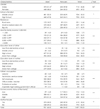1. Murphy SP, White KK, Park SY, Sharma S. Multivitamin-multimineral supplements' effect on total nutrient intake. Am J Clin Nutr. 2007; 85(1):280S–284S.
2. Block G, Jensen CD, Norkus EP, Dalvi TB, Wong LG, McManus JF, Hudes ML. Usage patterns, health, and nutritional status of long-term multiple dietary supplement users: a cross-sectional study. Nutr J. 2007; 6:30.

3. Radimer K, Bindewald B, Hughes J, Ervin B, Swanson C, Picciano MF. Dietary supplement use by US adults: data from the National Health and Nutrition Examination Survey, 1999-2000. Am J Epidemiol. 2004; 160(4):339–349.

4. Kim SH, Han JH, Kim WY. Consumption of health functional foods by elementary schoolchildren in Korea. Korean J Nutr. 2010; 43(2):161–170.

5. Park JS, Lee JH. Elementary school children's intake patterns of health functional foods and parent's requirements in Daejeon area. Korean J Community Nutr. 2008; 13(4):463–475.
6. Kim SH, Han JH, Hwang YJ, Kim WY. Use of functional foods for health by 14-18 year old students attending general junior or senior high schools in Korea. Korean J Nutr. 2005; 38(10):864–872.
7. Kim SH, Han JH, Kim WY. Health functional food use and related variables among the middle-aged in Korea. Korean J Nutr. 2010; 43(3):294–303.

8. Kim SN, Kim SH. A survey on use of vitamin·mineral supplements by children in Daejeon city and Chungcheong province in Korea. Korean J Food Cult. 2010; 25(2):117–125.
9. Knekt P, Ritz J, Pereira MA, O'Reilly EJ, Augustsson K, Fraser GE, Goldbourt U, Heitmann BL, Hallmans G, Liu S, Pietinen P, Spiegelman D, Stevens J, Virtamo J, Willett WC, Rimm EB, Ascherio A. Antioxidant vitamins and coronary heart disease risk: a pooled analysis of 9 cohorts. Am J Clin Nutr. 2004; 80(6):1508–1520.

10. Earnest C, Cooper KH, Marks A, Mitchell TL. Efficacy of a complex multivitamin supplement. Nutrition. 2002; 18(9):738–742.

11. Schuurman AG, Goldbohm RA, Brants HA, van den Brandt PA. A prospective cohort study on intake of retinol, vitamins C and E, and carotenoids and prostate cancer risk (Netherlands). Cancer Causes Control. 2002; 13(6):573–582.
12. White E, Shannon JS, Patterson RE. Relationship between vitamin and calcium supplement use and colon cancer. Cancer Epidemiol Biomarkers Prev. 1997; 6(10):769–774.
13. Olney RS, Mulinare J. Trends in neural tube defect prevalence, folic acid fortification, and vitamin supplement use. Semin Perinatol. 2002; 26(4):277–285.

14. Fawzi WW, Msamanga GI, Spiegelman D, Wei R, Kapiga S, Villamor E, Mwakagile D, Mugusi F, Hertzmark E, Essex M, Hunter DJ. A randomized trial of multivitamin supplements and HIV disease progression and mortality. N Engl J Med. 2004; 351(1):23–32.

15. Hathcock JN. Vitamins and minerals: efficacy and safety. Am J Clin Nutr. 1997; 66(2):427–437.

16. Kim H, Kim M. A study on health-functional foods intake pattern of consumers in Busan and Gyeongnam region. J Korean Living Sci Assoc. 2006; 15(2):341–352.
17. Han JH, Kim SH. Behaviors of vitamin · mineral supplement usage by healthy adolescents attending general middle or high schools in Korean. Korean J Nutr. 2000; 33(3):332–342.
18. The Korean Nutrition Society. Dietary reference intakes for Koreans. Seoul: The Korean Nutrition Society;2005.
19. Rock CL. Multivitamin-multimineral supplements: who uses them? Am J Clin Nutr. 2007; 85(1):277S–279S.

20. Gardiner P, Buettner C, Davis RB, Phillips RS, Kemper KJ. Factors and common conditions associated with adolescent dietary supplement use: an analysis of the National Health and Nutrition Examination Survey (NHANES). BMC Complement Altern Med. 2008; 8:9.

21. Stang J, Story MT, Harnack L, Neumark-Sztainer D. Relationships between vitamin and mineral supplement use, dietary intake, and dietary adequacy among adolescents. J Am Diet Assoc. 2000; 100(8):905–910.

22. Cha YS, Kim JS, Rho JO. A study on the patterns of nutrient supplement usage and its related influencing factors of high school students in Chonbuk area. J Korean Living Sci Assoc. 2007; 16(6):1231–1241.

23. Kim SH, Keen CL. Patterns of vitamin/mineral supplement usage by adolescents attending athletic high schools in Korea. Int J Sport Nutr. 1999; 9(4):391–405.

24. Statistics Korea. Advice Report of 2004 Population and Census. Seoul: Statistics Korea;2005.
25. Kim SH, Han JH, Zhu QY, Keen CL. Use of vitamins, minerals, and other dietary supplements by 17- and 18-year-old students in Korea. J Med Food. 2003; 6(1):27–42.

26. Kim SH, Han JH, Keen CL. Vitamin and mineral supplement use by healthy teenagers in Korea: motivating factors and dietary consequences. Nutrition. 2001; 17(5):373–380.

27. Kim SH, Keen CL. Vitamin and mineral supplement use among children attending elementary schools in Korea: A survey of eating habits and dietary consequences. Nutr Res. 2002; 22(4):433–448.

28. Yi HH, Park HA, Kang JH, Kang JH, Kim KW, Cho YG, Song HR, Lee JS. What types of dietary supplements are used in Korea? Data from the Korean National Health and Nutritional Examination Survey 2005. Korean J Fam Med. 2009; 30(12):934–943.

29. Herbold NH, Visconti BK, Frates S, Bandini L. Traditional and nontraditional supplement use by collegiate female varsity athletes. Int J Sport Nutr Exerc Metab. 2004; 14(5):586–593.

30. Han JH, Kim SH. Vitamin · mineral supplement use and related variables by Korean adolescents. Korean J Nutr. 1999; 32(3):268–276.
31. Nieman DC, Gates JR, Butler JV, Pollett LM, Dietrich SJ, Lutz RD. Supplementation patterns in marathon runners. J Am Diet Assoc. 1989; 89(11):1615–1619.

32. Al-Naggar RA, Chen R. Prevalence of vitamin-mineral supplements use and associated factors among young Malaysians. Asian Pac J Cancer Prev. 2011; 12(4):1023–1029.





 PDF
PDF ePub
ePub Citation
Citation Print
Print






 XML Download
XML Download